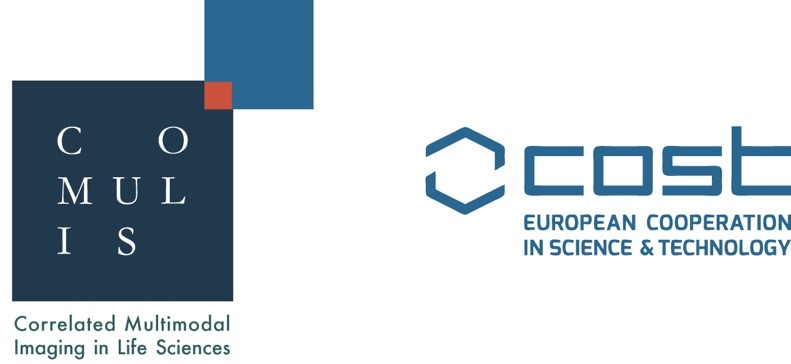COMULIS COST Action: Funding for correlated multimodality imaging projects
Published: 2020-10-22
Correlated multimodality imaging (CMI) is a way to gather holistic information about an individual specimen. The CMI process of combining two or more imaging techniques to a single sample results in a greater understanding of the sample’s macro, meso- and microscopic structure, dynamics, function and chemical composition. CMI therefore has huge potential in biological and biomedical research. To make CMI a more standard practice, COMULIS - Correlated Multimodal Imaging in Life Sciences – was formed by Austrian BioImaging/CMI as an EU-funded COST Action which aims to fuel the urgently needed collaborations in the field of CMI.
Two unique funding opportunities
In order to encourage correlated multimodality imaging projects, COMULIS’ Short Term Scientific Missions (STSMs) provide travel grants to individuals wishing to explore imaging techniques they do not have access to. The grants are presented in the form of a lump sum of up to 3,500 Euros (depending on the duration of the mission), to cover travel and subsistence. COMULIS accepts applications on a continuous basis from Early Career Investigators and Experienced Imaging Scientists who would like to travel internationally to collaborate with a host facility on a correlated multimodality imaging project. There is a rapid review process and around 10 grants are awarded every year.
In addition, COMULIS’ STSMs can provide funding for core facility staff to learn a new imaging technique and their combination with another modality or work with new correlation software tools to bring the expertise back to their own facility.
Fund access to a Euro-BioImaging Facility with COMULIS STSMs
Euro-BioImaging provides access to 40+ different imaging technologies in 21 Nodes (imaging facilities) located across Europe. Many Euro-BioImaging Nodes are interested in hosting STSM. Please visit our Node page for a comprehensive list of Nodes. Please contact info@eurobioimaging.eu for more information about correlative imaging projects in specific facilities.
Some ideas for correlated multimodality projects
In addition, COMULIS can help fund studies using a correlative approach including the novel imaging techniques featured in the Euro-BioImaging Proof-of-Concept studies.
Mass Spectrometry-based Imaging (MSI):
In addition to MSI, the Advanced Light Microscopy Italian Node provides access to other modes of imaging including fluorescence and light microscopy, electron microscopy and Raman microscopy. This facility presents a unique opportunity for correlative imaging where MSI can be coupled to other modes of imaging to provide enhanced information. Learn more
Photoacoustic Imaging (PAI):
The MMMI Italian Node is equipped with all the state-of-the-art in vivo imaging technologies. Among them, high frequency ultrasound is naturally combined with PAI, and all the PAI scanners in the Node are fully integrated with an Ultrasound imager. In principle, PAI can be combined with optical and MR scanners, though efforts are required for allowing the co-localization of the two images. With a longstanding and strong expertise in all the molecular and clinical imaging technologies represented in Euro-BioImaging portfolio (MRI, nuclear medicine, optical imaging, ultrasound), the MMMI Italian Node allows the execution of validation and comparative investigations on site. Learn more
Coherent Anti-stokes Raman Scattering (CARS):
The imaging facilities in our Helsinki Node, part of the Finnish Advanced Light Microscopy Node provide access to most of the commonly used microscopy techniques varying from in vivo optical microscopy to electron microscopy. Therefore, multimodal imaging combining CARS with other techniques is possible here. As an interesting example, we have demonstrated correlative CARS and electron microscopy to study cell-nanoparticle interactions. We collaborate also with other facilities and departments, and can help getting access to additional sample preparation and analysis methods. Learn more
At Euro-BioImaging’s Prague Node, the CARS modality has been implemented to extend further the capabilities of already quite powerful laser scanning microscope with a choice of spectral and time-resolved detection. Therefore, multiple techniques can be readily combined in a single multi-modal set-up. Potential techniques that can be combined are conventional fluorescence confocal imaging, 2-photon imaging, second-harmonic generation, and 2-photon-excited fluorescence lifetime imaging (FLIM). Learn more
Structured Illumination Microscopy (SIM):
At Euro-BioImaging’s Prague NodePrague Node, when spatial resolution offered by SIM is not sufficient, the experts also offer STED and single-molecule localization technologies provided the sample can be prepared according to the requirements of these methods. In super-resolution microscopy, they offer a complete service, and help our users at every step of the workflow, from proper sample preparation to imaging to image analysis. Learn more
Quantitative Phase Imaging (QPI):
At Euro-BioImaging’s Prague Node, a wide range of light microscopy technologies - from fluorescence widefield microscopy through confocal scanning or spinning disk microscopy to various super-resolution approaches- are available. Hence, scientists can build on their observation of cellular behavior obtained by QPI imaging and easily dive into high-resolution techniques to further explore underlying mechanisms at subcellular or even single-molecule level. Learn more
Learn more!
Euro-BioImaging supports open access to many more Nodes and technologies! Visit our Web Portal for more information – and view our full portfolio of technologies.
To read about COMULIS and its full list of opportunities, visit the COMULIS website.
For examples of successful, COMULIS STSM-funded projects, click here.
